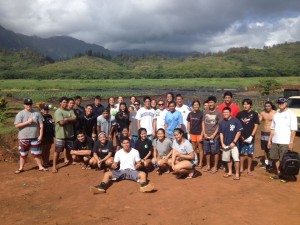After 20 years of planning, Kamehameha Schools, Kapālama celebrated the grand opening of their new Hawaiian cultural center.
“Our cultural center is called Kaʻiwakīloumoku, which is another name for Kamehameha The Great,” says Randie Fong, Director, Hoʻokahua of the Hawaiian Cultural Development at Kamehameha, Kapālama.
There are three piko of this Hawaiian cultural center, the assembly hall, the largest house and the foundation on which these two buildings stand, Kūkuluokahiki.
“For majority of our 125 years the focus has been on Western education,” says Randie. “And although this type of education is still very important, we cannot forget about our Hawaiian education.”
And Micah Kāne, who is Chariman of the Board of Trustees at Kamehameha, Kapālama could not have agreed more.
“We want our children to see the world through the prism and it’s very difficult to put it to words what that looks like other than to just be here today and experience the Aloha that’s here and the strength and the mana thatʻs around us and the history that got us to this point.”
“At this Hawaiian cultural center, Hawaiian behavior and values are highly engouraged,” says Randie.
This combination of people, young and old, represents the trans-generational design of Kaʻiwakīloumoku, which was evident in Nainoa Thompson’s speech honoring his father, for whom the Hale Mana is named after.
“My father said this place is a place that you need to bring people together. That is a commitment not just to Hawaiʻi, not just to Hawaiians, but to the Pacific,” says Nainoa Thompson who is the Master Navigator and President of the Polynesian Voyaging Society. “So we arrive here today, the greatness of my dad is not going to be measured in what he did, in my humble opinion it’s going to be in those seeds that he planted in leadership for the future.”
“He held it special for his beliefs in true leadership that were guided by the kinds of values that define what it is to be Hawaiian.”
“You can talk about leadership all you want, but if the students have good examples to watch and to follow after, only then will true leaders emerge from within our students,” says Randie.
Ma hope o ka iwakalua makahiki o ka hoʻolālā kūpono ʻana i ko Kamehameha holomua ʻana ma ka hoʻonui ʻike Hawaiʻi, ua wehe ʻia nā ʻīpuka o ko Kamehameha Kapālama hale kula hou e kālele ana ma ka nohona Hawaiʻi.
“Ua kapa ʻia kēia wahi ʻo Kaʻiwakīloumoku, he ʻano inoa, inoa kapakapa ma kekahi noʻonoʻo, akā he inoa nō, he inoa maoli nō kēlā no Kamehameha ʻEkahi, ʻo Kaʻiwakīloumoku,” wahi a Randie Fong, ka Hoʻokahua ʻIke Hawaiʻi o Kamehameha, Kapālama.
He ʻekolu piko o ua hale kula nohona Hawaiʻi nei, ʻo ka hale ʻaha ʻoe, ʻo ka hale mana ʻoe a ʻo ke kahua hoʻi kahi i kūkulu ʻia ai kēia mau hale ʻelua nei, ʻo Kūkuluokahiki.
“No ka hapa nui o ka hoʻokahi haneli iwakāluakūmālima mau makahiki, mea nui ke aʻo Haole, nohona Haole,” wahi a Randie. “So ʻaʻole kēia he kāpae, he mea, mālama i ka ʻaoʻao Haole, he mea nui kēlā, he maikaʻi, he waiwai ko laila, akā pehea hoʻi ka ʻaoʻao o ka Hawaiʻi?”
A ʻaʻole i hiki ke hōʻole ʻia kēia manaʻo e Micah Kāne, ka luna hoʻomalu o nā kahu waiwai ma Kamehameha, Kapālama.
“Makemake mākou e ʻike nā haumāna i ka honua ma o kēia hale ma ke ʻano he ʻōpaka. ʻAʻole moakāka loa kēlā kiʻi iā mākou i kēia manawa akā naʻe ua hiki ke kuhi ma o nā haʻawina o ke aloha a me ka mana e puni ana iā mākou a hiki loa i kēia.”
“No kēia hale, ʻo ka nohona Hawaiʻi, ke ʻano, ka lawena, ka maʻemaʻe o ka naʻau, you know, mea nui kēlā, nā mea i aʻo ʻia mai nā mākua, mai nā kupuna,” wahi a Randie.
He hōʻailona kēia launa pū ʻana o ka poʻe kūpuna, ka poʻe makua a me nā haumāna i ke ʻano i kūkulu ʻia ai ʻo Kaʻiwakīloumoku ma ka hoʻomanaʻo ʻana i ke ʻano e hoʻōla mau ai ka ʻike i waena o nā ēwe o ka puʻupuʻu hoʻokahi. A ua ʻike ʻia nō kēia pilina moʻokūʻauhau i loko o ko Nainoa Thompson haʻiʻōlelo e hoʻāno ana i kona makua kāne nona ka inoa o ka Hale Mana o ua kahua kula hou.
“Wahi a kuʻu makua kāne, he wahi kēia e ʻākoakoa ai ka poʻe Hawaiʻi a me ka poʻe a pau a puni ka Pākīpika,” wahi a Nainoa Thompson ka Hoʻokele Waʻa a me ka Pelekikena o Polynesian Voyaging Society. “Ua hōʻea mākou i kēia lā, he mau hua o kāna hana a aia i loko o kā mākou hana kona pono e ola mau ai.”
“He mea nui iā ia kēia manaʻo o ke alakaʻi kūpono ʻana ma ke ʻano Hawaiʻi.”
“Inā hiki i nā haumāna ke ʻike maka i ka hana a nā mākua, you know, and then hoʻopili, mea nui kēlā. Hiki ke walaʻau e pili ana i ke alakaʻi ʻana, but inā hiki ke ʻike maka, hoʻopili a hoʻāʻo, ma laila e ulu ai ke alakaʻi kūpono ʻana i waena o nā haumāna, so mea nui,” wahi a Randie.
2 Comments
-
Aw, this was a very good post. Taking a few minutes and actual effort to produce a top notch
article… but what can I say… I put things
off a whole lot and never seem to get anything done. -
What’s up everyone, it’s my first visit at this site, and piece of writing is actually
fruitful in support of me, keep up posting these types of content.





